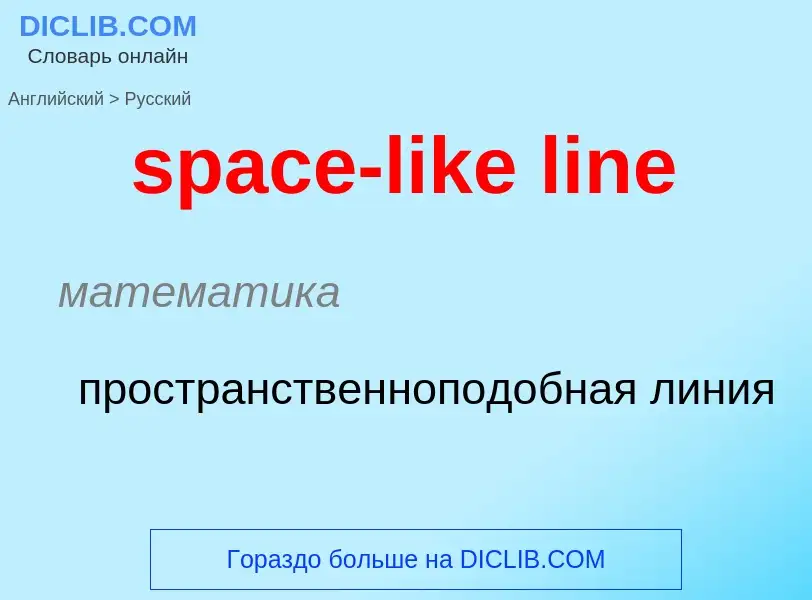Vertaling en analyse van woorden door kunstmatige intelligentie ChatGPT
Op deze pagina kunt u een gedetailleerde analyse krijgen van een woord of zin, geproduceerd met behulp van de beste kunstmatige intelligentietechnologie tot nu toe:
- hoe het woord wordt gebruikt
- gebruiksfrequentie
- het wordt vaker gebruikt in mondelinge of schriftelijke toespraken
- opties voor woordvertaling
- Gebruiksvoorbeelden (meerdere zinnen met vertaling)
- etymologie
space-like line - vertaling naar russisch
математика
пространственноподобная линия
[laik]
общая лексика
вероятно
возможно
вроде
одинаковый
одноименный
однородный
подобно
подобный
похожий
равный
сходный
схожий
прилагательное
[laik]
общая лексика
подобный
похожий
равный
одинаковый
похожий, подобный
одинаковый, равный
вероятный
собирательное выражение
возможный
наречие
[laik]
общая лексика
подобно, так
возможно, вероятно
редкое выражение
вероятно
просторечие
вроде
так сказать
как бы
собирательное выражение
так сказать, как бы
союз
[laik]
просторечие
как будто
словно
разговорное выражение
как
существительное
[laik]
общая лексика
чьё-л. подобие
такой же человек
что-л. подобное или похожее
обыкн. вкусы
нечто подобное, равное, одинаковое
склонности, влечения
предлог
[laik]
общая лексика
так
как кто-л.
как что-л.
like anything, like mad - [собир.] стремительно
изо всех сил
сильно, чрезвычайно, ужасно
глагол
общая лексика
любить (что-л.)
хорошо или одобрительно относиться к чему-л.
кому-л.
предпочитать
выбирать
хотеть
желать
нравиться, любить
шутливое выражение
подходить
сочетаться
согласоваться
диалектизм
нравиться
математика
трехмерное пространство
Definitie
Wikipedia

The Kármán line (or von Kármán line ) is a proposed conventional boundary between Earth's atmosphere and outer space set by the international record-keeping body FAI (Fédération aéronautique internationale) at an altitude of 100 kilometres (54 nautical miles; 62 miles; 330,000 feet) above mean sea level. However, such definition of the edge of space is not universally adopted.
The Kármán line has no particular physical meaning, in that there is no noticeable change in the characteristics of the atmosphere across it, but is important for legal and regulatory purposes, since aircraft and spacecraft are subject to different jurisdictions and legislations. International law does not define the edge of space, or the limit of national airspace.
The line lies well above the altitude reachable by a conventional airplane or a high-altitude balloon, and is approximately where satellites, even on very eccentric trajectories, will decay before completing a single orbit.
While experts disagree on exactly where the atmosphere ends and space begins, most regulatory agencies (including the United Nations) accept the FAI's Kármán line definition or something close to it. As defined by the FAI, the Kármán line was established in the 1960s. Various countries and entities define space's boundary differently for various purposes.
The Kármán line is named for Theodore von Kármán (1881–1963), a Hungarian-American engineer and physicist who was active in aeronautics and astronautics. In 1957, he was the first person to attempt to calculate a theoretical limit of altitude for airplane flight.


![Atmospheric gasses scatter blue wavelengths of visible light more than other wavelengths, giving the Earth's visible edge a blue halo. The [[Moon]] is seen behind the halo. At higher and higher altitudes, the atmosphere becomes so thin that it essentially ceases to exist. Gradually, the atmospheric halo fades into the blackness of space. Atmospheric gasses scatter blue wavelengths of visible light more than other wavelengths, giving the Earth's visible edge a blue halo. The [[Moon]] is seen behind the halo. At higher and higher altitudes, the atmosphere becomes so thin that it essentially ceases to exist. Gradually, the atmospheric halo fades into the blackness of space.](https://commons.wikimedia.org/wiki/Special:FilePath/Top of Atmosphere.jpg?width=200)

